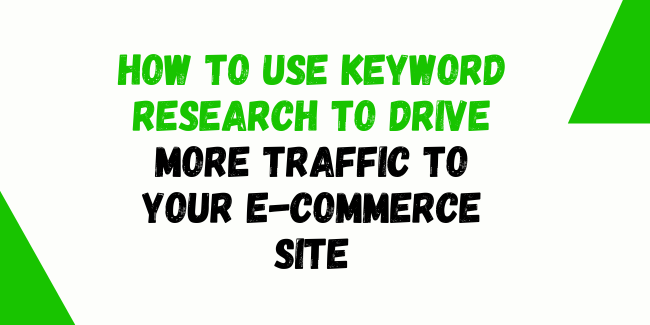In today’s competitive digital marketplace, understanding keyword research is critical for improving exposure, attracting quality traffic, and increasing conversions on your e-commerce site. By identifying the correct words and using them best, businesses can compete better in SEO and online sales. In this blog post, we’ll teach you how to properly and efficiently use keywords to increase the visibility of your platform, raise the conversion rate, and bring potential buyers to your store who intend to buy.
Explore our SEO freelancer services to boost your website’s Google rankings.
Why Keyword Research Is Essential for E-commerce Success
Getting acquainted with the role of keyword research opens up the way to a successful e-commerce SEO strategy. The following are the main advantages:
1. Improves Search Engine Visibility
This technique embeds relevant keywords into product titles, descriptions, and blog content to help search engines recognize similar products. This leads Google to display the page as an appropriate site.
2. Target Buyer Intent Effectively
Keyword research enables you to find searches that are highly likely to convert. In practice, phrases like “buy leather jackets online” clearly signal to the user that the product selection is over and he is about to proceed to the payment process, making these keywords essential for increasing the conversion rate.
3. Reduces Paid Advertising Costs
By focusing on keywords organically and maintaining lower dependence on PPC campaigns, you can have a significant drop in the expenses involved in advertising. Earning consistent traffic without spending repeatedly is only possible when you are at the top of organic search results for searches with purchase intent.
How to Find High-Converting Keywords for Your Online Store
It is a must to find keywords that are not only relevant but also appealing and responsive. The following is the right way to determine them:
1. Analyze Customer Search Behavior
Analyzing the data in Google Search Console and the site search box lets you see customer terms, such as input tracking, and real-time affluent shopping trends.
2. Focus on Product-Specific Keywords
Do not think traffic will be driven by generic terms such as “shoes”; this is incorrect. If we take product-specific terms, e.g., “men’s waterproof hiking boots,” they are more precise and to the point, but their intention is even better—this is why they are better for converting.
3. Monitor Competitor Keywords
Aids in the process of competitor keyword spying, Ahrefs, and SEMrush are potent tools to make use of. The basic thing here is understanding what keywords they rank for and how their visitors find them.
4. Use Seasonal and Trend-Based Terms
E-commerce is where you will find a significant hike in sales thanks to implementing different joyful events. Recognizing terms like “Black Friday TV deals” when other terms are trending can provide a quick infusion of traffic (Tellefsen 1999).
Want to learn why a tailored SEO plan is crucial for online success? Read our full guide on Why Your Online Store Needs a Custom SEO Strategy.
Using Long-Tail Keywords to Attract Ready-to-Buy Customers
Long-tail keywords are keywords that have lower search volumes but high search intent. They are highly targeted traffic. The reason is as follows:
1. Capture Niche Search Traffic
When customers use a specific search word like “affordable vegan leather jackets for women,” that word with numbers and price, it is obvious what they want. A focused audience will pursue the information with a greater likelihood of buying.
2. Trigger a High Purchase Interest
Customers who search for long-tail keywords are generally in the latter stage of the purchase cycle. They have a clear idea of what they need and are more likely to take action.
3. Face Lower Competition
Getting a grip on long-tail keywords, which are low-competition, is less demanding. A new or smaller e-commerce store is a good option.
Tools and Techniques to Make E-commerce Keyword Research
Applying the right tools and resources ensures the effectiveness and data-driven nature. The following are some of the most effective ways:
1. Use Google Keyword Planner
This no-cost resource is designed for searching for keyword ideas, traffic volume estimation, and competition level assessment tasks.
2. Dictate with SEMrush or Ahrefs
Both high-end tools provide insight into your competitors, uncover broad keyword gaps in your content, and provide the means to predict a site’s probable traffic.
3. Dig into Ubersuggest and AnswerThePublic
These unofficial (paid) resources support the generation of the best query-based keywords from the pool of linking words for a particular content piece.
4. Study Amazon and eBay Recommendations
Enter your product on the two e-commerce sites and see what suggestions appear. These recommendations are often derived from the real search requests made by the consumers and, therefore, provide business opportunities.
Optimizing Product Pages and Content with Targeted Keywords
Once you have your keywords, the next step is strategic placement across your website. Here’s how to do it:
1. Reword and Refine Product Titles
Make your titles and descriptions look more natural without overusing the main keywords. Let the users see the content first, and then the search engines.
2. Improve Meta Titles and Tags
Employ the main keywords in the page’s meta titles and descriptions to increase click-through rates from search engine results pages (SERPs).
3. Add Keywords to Blog and Category Pages
Throughout your content, incorporate related keywords that you use in the blog posts and category pages to create a well-linked, keyword-rich domain.
Is investing in professional SEO services the right move? Discover the pros and cons in our article on Is It Worth Hiring Someone for SEO?
Conclusion
The right keyword research strategy can lead you to create a highly potent digital marketing solution, such as driving massive traffic to your e-commerce site. By knowing buyer intent, using long-tail keywords, using RDS, and using the right tools to optimize your site, you can soon find your organic traffic growing and your conversions skyrocketing. Apply these strategies now to have a solid foundation for your e-commerce SEO and attract customers who are one step away from purchasing.

